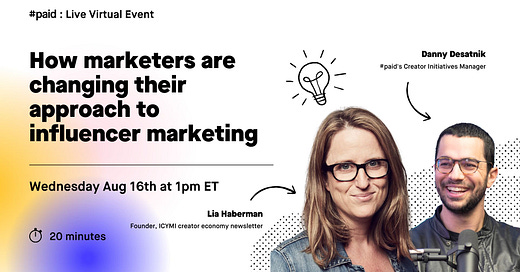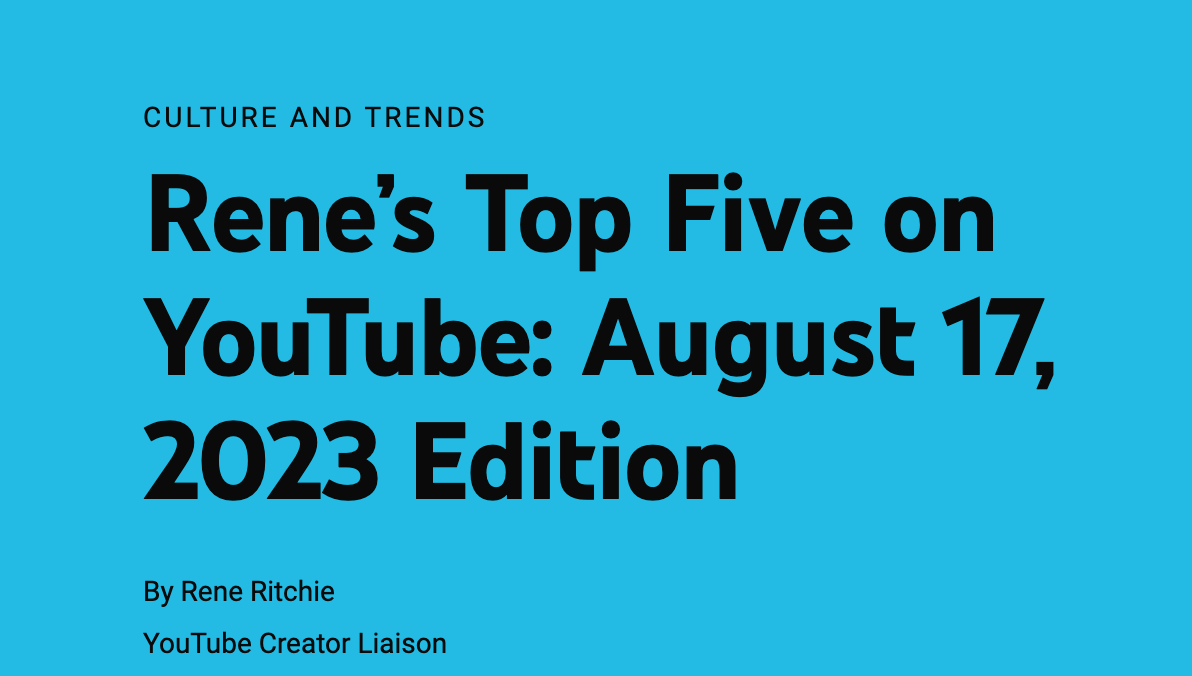Hello! I’m still catching up on news and emails so I’ve included a couple of last week’s headlines because they’re officially worth noting — but overall it seems like the entire industry’s gone on vacation this month.
So, I’m busy planning for Fall: Classes; Consulting (brands, reach out if you want to work together before my schedule firms up!); And coming up with some newsletter ideas. If you’re a paid subscriber, I’ll be sending a follow up email asking for your thoughts.
⏰ 1-SECOND SUMMARY
YouTube’s Rene Ritchie shares 5 tips for getting started
More thoughts from my interview with #Paid’s Danny Desatnik on episodic social series
Instagram creators can now invite up to three friends to co-author a Collab post
TikTok darling Elf Cosmetics is embracing OOH advertising
💻 ROADMAP
📲 YouTube is testing some new features, including:
Q&A stickers on Shorts. Viewers can reply via comments and, unlike Instagram’s Story Q&A, responses are visible in comments.
ID’ing key concepts for educational videos. YouTube would automatically surface more info about these concepts with images and short text snippets on the video’s watch page.
A new “For You” section on channel homepages. Viewers would see personalized picks on channel homepages based on the videos they've already watched.
📲 YouTube Music is introducing a Samples tab. It’s a feed of short form video content meant to drive new music and artist discovery.
📲 Instagram creators can now invite up to three friends to co-author a Collab post or reel together.
📲 TikTok just released a Travel Playbook for SMB advertisers in the space.
📲 New York City is banning TikTok from city-owned devices due to concerns that the platform “posed a security threat to the city’s technical networks.”
📲 Elon Musk’s X is throttling traffic to websites he dislikes, according to a Washington Post analysis. Users are experiencing up to a 5-second delay when clicking through to online rivals Facebook, Instagram, Bluesky and Substack, as well as the Reuters wire service and the New York Times.
📲 Snapchat's My AI chatbot glitched. Or became sentient. Either way, people freaked out.
5 Quick Tips for Starting on YouTube
YouTube’s Creator Liaison Rene Ritchie (who, arguably, has the best job in the world as a bridge between creators and the video platform) recently started publishing a new weekly Top Five list of the things for creators should know/see/watch/read that week.
In honor of his new weekly column (part of YouTube’s Culture & Trends blog), I asked Rene for his top 5 tips for anyone who hasn’t launched their YouTube channel yet.
Open the YouTube app on your phone, tap the Shorts tab, swipe through the feed, and get inspired! Every day, millions of people share opinions, fun facts, expert knowledge, interesting situations, skits, songs, dances, and so much more. There's no right or wrong way to show up — you be you!
When you know what you want to share, tap the + button, bottom center, film yourself or your situation and post away!
If you're stuck for an idea, go back to the feed and look for a trend that you vibe with. Tap the 'Remix button', then tap on 'Use this Sound' and make your own version!
If there's an opinion you feel passionate about, agree or disagree, tap on 'Cut This Video' or 'Green Screen' to create a new Short where you can add your views after or over the original
Everyone on YouTube had a first video, so don't overthink yours. Just do it — and then follow it up with a second or third!
So, what are you waiting for?!
What Creators & Brands Can Learn from TV
Say What: This week I talked to #Paid’s Danny Desatnik about the creator trend toward episodic, TV-style content on social — these are series revolving around a specific theme or topic that are often a twist on a creator’s regular creative output, curated through playlists or hashtags.
Examples, Please: The appeal of episodic content isn’t exclusive to one platform or content format. It might have formerly been associated with TV but the concept of episodic series have made the jump to podcasts, video and even photo carousels.
“Hot Ones” from First We Feast and Vogue’s “73 Questions” are good examples of YouTube episodic series.
Remi Bader’s #RemisRealisticHauls on TikTok are a great example of a creator taking something like the GRWM or Fit Check format and developing a personalized version.
There are multiple lifestyle series on Instagram, especially from foodies such as the LA Times’ Jenn Harris and her “The Best Thing I Ate” carousels. One of my favorites is an oldie but goodie from the head of Instagram fashion partnerships: Eva Chen’s taxi cab selfies titled #EvaChenPose.
Most channels will have a mix of episodic content sprinkled in with life and work updates. Keith Lee’s famous Taste Test TikToks are mixed in with family, travel and work updates. On the flip side, an example of a creator who’s made episodic their entire channel would be someone like TikTok’s Ted Zhar and his “What do you do for a living?" content series.
But Why: Grabbing and keeping people’s attention is getting harder and harder. You’ve either got to spend a ton of money or create something special that stands out in a sea of sameness. Episodic content is a good way for a creator to deep dive into an area they and their audience are passionate about while not necessarily pivoting their entire content strategy.
The Benefit for Creators:
Platforms are prioritizing interest-based content which has put more of an emphasis on niching down than ever before. Episodic tends to focus on topics audiences feel passionately about.
Creators get to develop a defining franchise that, if they’re lucky, viewers will come to know and love.
It can help avoid burnout. It’s a lot more sustainable to plan, produce and distribute an episodic series than it is to wake up and figure out what trend to chase that day.
The Benefit for Brands:
People’s attention is shifting: Americans are spending less time watching traditional TV than they are streaming services and other platforms. This is an opportunity to follow the eyeballs.
It’s a consistent and extended opportunity for promotion, whether through a brand-owned series or by sponsoring a creator-led series.
By collaborating with a creator, brands are able to tap into their audience insights (they know what people want to watch!) and get to position the creator as a character within this recurring franchise that’s being established.
Hollywood Takeaways:
There are some tried and true elements you can borrow from the entertainment industry as you think about developing episodic content.
Good storytelling
People watch TV; not ads. So it’s important not to think of this as an infomercial but as compelling content that dwells in a space adjacent to a brand’s product or service. Think of people’s favorite unscripted installments that work equally well on TV, streaming or social: Whether it’s Jeopardy, Love Island or MrBeast’s real-life Squid Game, people love the thrill and suspense of game show competition. Talk shows and lifestyle shows also tap into popular motivators of discovery, connection, acquiring information or undergoing transformation.
Familiar elements
Even as each episode introduces a new situation or challenge, familiarity is a big motivator in getting people to follow along. Look to create recurring elements that people can recognize even out of context, such as:
Audio cues - think of your audio like an old-school TV theme song, people’s ears should perk up at the sound
Visual cues - whether it’s the name of your “series” or branding elements like the color scheme and graphics (hello, Barbie pink!)
The cast - audiences want some predictability as to who they watch each week. Even if we don’t see Zhar on TikTok, the voice and first person POV stays the same.
The schedule - even some streaming services are starting to move away from the binge model to more scheduled releases. By releasing your series on a consistent schedule — same day and time every week or month — you create anticipation and reward for your viewers.
📖 ON YOUR RADAR
Content Creator Appreciation Day was August 15, according to Planoly. Count me in, who doesn’t want to celebrate their favorite creator?! Plus Planoly is offering a special code to ICYMI readers for 3 free months. CODE: contentcreatorday
TikTok teens created and promoted a fake 80s horror movie called ‘Zepotha.’ It’s the brainchild of this creator. I’m in awe.
This guy faked an entire 90s Europop band. Slate has a good explainer if Planet of the Bass has you scratching your head.
Charli D’Amelio is on a TikTok tear. After posting sporadically most of this year, she posted four times on Monday. Something’s up, right?
Here’s an interesting example of Elf Cosmetics — probably best known for their TikTok hits — embracing OOH advertising.
💡 THOUGHT STARTERS
Here’s a recap of reports and articles I was honored to be a part of recently:
The LinkedIn team said I had one of the best creator economy newsletters on the platform. Woot! But I’d love to see even more female voices in my feed. LinkedIn’s Marketing Voices Hub aims to be a resource providing weekly updates with industry news, content creation tips, product updates, inspiration, and Voices to follow.
The American Influencer Council (AIC) and Traackr collaborated on a trend report that examines career creators' barriers to going full-time — 47% of the responders felt stressed about their finances — plus, a quote from me. Get the report!
I spoke to Phoebe Bain on the pros and cons of the "founder as an influencer" strategy for this AdAge piece: DTC Founders As Influencers — Behind the Marketing Risks and Rewards.
I spoke to Chris Stokel-Walker on the benefits and potential pitfalls of an influencer using an AI model to reproduce his physical presence for this Wired piece: One of Gaming’s Biggest YouTubers Wants to Replace Himself With AI.
Thanks for reading! Come back next week for that new pencil smell and a back to school giveaway 📚







Welcome back! Great edition as always